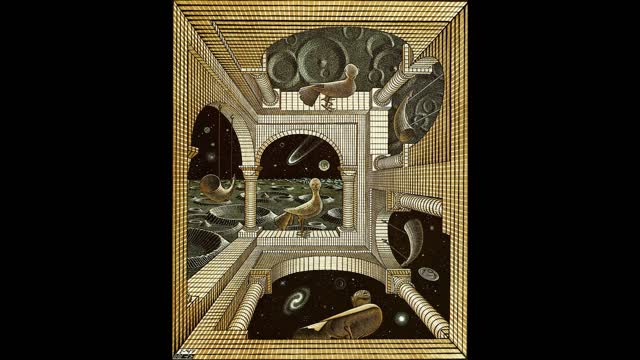Premium Only Content

Mike Fish - 'Impossibilities' - Suite for Large Orchestra (2021)
‘Impossibilities’ is a six-part orchestral suite, centred around the work of the famous Dutch artist, M.C Escher. Escher's world is a surreal and occasionally frightening world of paradoxes, optical illusions, strange patterns and fictional creatures. The music was borne out of a desire to convey the dementing feeling of being in continuous and sustained lockdown, due to the coronavirus pandemic. In a world which has currently been turned upside down with increasing volatility, Escher's work provided the perfect synthesis of playfulness and demented nonsense.
I – Introduction (00:00)
A brief introduction to Escher and the resultant musical landscape, based upon his most well-known work, ‘Relativity’. Faceless, mannequin-like people travel up and down a series of endless staircases. These staircases
appear to lead into each other and seem to end nowhere. The orchestra engages in an off-kilter dance rooted in the whole-tone scale, with the Xylophone representing the mechanical travel of the people.
II – Dragon (00:55)
Inspired by Escher’s work of the same name, this movement depicts an ouroboros dragon attempting to break out of his own paradox. In Escher's words: "This dragon is an obstinate beast, and in spite of his two dimensions, he persists in assuming that he has three." This movement makes extensive use of Olivier Messiaen’s 2nd Mode of Limited Transposition, with long-sustained chords in the woodwinds, brass and lower strings, conveying the static nature of the wood engraving. Trumpets, 1st Violins, Xylophone and Glockenspiel represent the desperation of the dragon to escape his prison.
III – Night Forest (04:28)
This movement is a dark scherzo based on ‘Scholastica’, an early surrealist work created by Escher in 1931. A dark forest with withered trees is shown. We see owls, mice, snakes, dogs and cats with grotesque expressions all congregating in the midst of this shadowy realm. The music is fixed within the Hungarian Minor Scale (in A), with the central dance inspired by the funeral march from Gustav Mahler’s 1st Symphony and the ‘laughter through tears’ aesthetic of much Jewish Klezmer music. The music eventually sinks into a murky final A Minor chord.
IV – House of Stairs (07:34)
The 4th movement is a depiction of Escher's grotesque 'House of Stairs'. In this variation on his endless staircases, a collection of 46 creatures created by Escher himself, known as 'Curl Ups' or 'Wentelteefje' are crawling up and down. These creatures are elongated and armoured, with six human feet for legs and a disc-shaped head with a parrot-like beak and eyes on stalks on either side. The music follows the development and recapitulation of two-primary themes. The first (in 5/16) represents the demented dizziness of the staircases, the second is a military-like march representing the Wentelteefje, as they relentlessly ascend and descend.
V – Another World (10:08)
The 5th movement is a chorale depicting Escher's mysterious 'Another World', in which we see a paradoxical arched structure in space, populated through many angles by metal sculptures of birds with human faces. The music is deliberately very slow, reflecting the absence of time in this surreal realm. Olivier Messiaen’s Third Mode of Limited transposition informs the harmonic language, with the Tam-Tam and Vibraphone providing an extra layer of other worldliness. As the music sinks and fades, we are left perpetually hanging, lingering in a world of surreal paradoxes. In performance, there should be a significant silence before the final movement.
VI – Apotheosis (13:20)
The last movement is conceived as a final short burst of Escher’s world, in which the quality of playful madness is brought to a climax. The movement is in 3/4 and is nominally a waltz, with many traditional Viennese waltz chord progressions. However, the harmonies are suffused with tritones and the key changes regularly, with the tempo gradually increasing with each episode. The image depicted is of someone climbing a series of Escher staircases, with each successive staircase being more outlandish, warped and difficult to climb. Eventually, the danger becomes too much, the protagonist loses their balance and falls. The piece finishes with a hammering from the orchestra in the whole-tone scale which opened the suite.
ORCHESTRA
1 Piccolo, 2 Flutes, 2 Oboes, 2 Clarinets in Bb, 2 Bassoons, 1 Contrabassoon, 4 Horns in F, 2 Trumpets in Bb, 2 Trombones, 1 Tuba, 5 Timpani (C, D, E, F#, G#), Snare Drum, Bass Drum, Whip, Tambourine, Tam-Tam (Large), Xylophone, Glockenspiel, Vibraphone, Violins 1 (16 - 20), Violins 2 (14 - 18), Violas (12 - 16), Cellos (10 - 14), Double Basses (8 - 12).
SUPPORT MY WORK
Paypal Donations: https://paypal.me/mikefishmusic
-
 13:30
13:30
WhaddoYouMeme
17 hours ago $3.59 earnedIt All Makes Sense Now
11.6K21 -
 2:00:05
2:00:05
Nick Freitas
16 hours agoIs Conservatism Dead?
12.8K18 -
 LIVE
LIVE
PudgeTV
8 hours ago🟠 Gaming on Rumble | Frostpunk 2 - Completing Chapter 2
82 watching -
 22:07
22:07
Jasmin Laine
17 hours ago'You Think This Is NORMAL?!'—U.S. Official STUNS CTV With BRUTAL Mic Drop
13.4K37 -

BEK TV
1 day agoTrent Loos in the Morning - 7/31/2025
10.6K -
 LIVE
LIVE
The Bubba Army
22 hours agoShannon Sharpe FIRED after Sex Lawsuit - Bubba the Love Sponge® Show | 7/31/25
1,580 watching -
 21:23
21:23
DeVory Darkins
1 day ago $9.80 earnedTrump makes STUNNING Admission regarding Epstein and WSJ settlement
31.9K104 -
 8:14
8:14
MattMorseTV
17 hours ago $7.20 earnedTrump just DROPPED the HAMMER.
40.2K43 -
 2:47:03
2:47:03
Patriot Underground
20 hours agoTruthStream RT w/ Joe & Scott (7.30.25 @ 5PM EST)
52K30 -
 42:04
42:04
World2Briggs
17 hours ago $2.19 earnedRanking All 50 States By Natural Beauty Will Shock You!
16.2K4